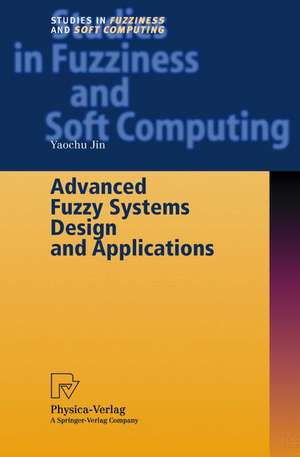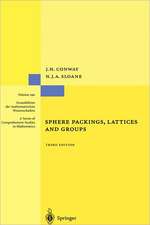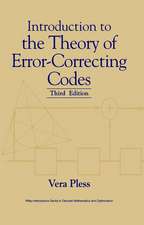Advanced Fuzzy Systems Design and Applications: Studies in Fuzziness and Soft Computing, cartea 112
Autor Yaochu Jinen Limba Engleză Hardback – 18 noi 2002
| Toate formatele și edițiile | Preț | Express |
|---|---|---|
| Paperback (1) | 619.89 lei 6-8 săpt. | |
| Physica-Verlag HD – 12 dec 2011 | 619.89 lei 6-8 săpt. | |
| Hardback (1) | 621.48 lei 6-8 săpt. | |
| Physica-Verlag HD – 18 noi 2002 | 621.48 lei 6-8 săpt. |
Din seria Studies in Fuzziness and Soft Computing
- 20%
 Preț: 961.00 lei
Preț: 961.00 lei - 20%
 Preț: 627.83 lei
Preț: 627.83 lei - 20%
 Preț: 949.14 lei
Preț: 949.14 lei - 20%
 Preț: 1010.14 lei
Preț: 1010.14 lei - 20%
 Preț: 1008.57 lei
Preț: 1008.57 lei - 20%
 Preț: 1113.52 lei
Preț: 1113.52 lei - 20%
 Preț: 617.49 lei
Preț: 617.49 lei - 20%
 Preț: 962.94 lei
Preț: 962.94 lei - 18%
 Preț: 917.09 lei
Preț: 917.09 lei - 20%
 Preț: 317.55 lei
Preț: 317.55 lei - 20%
 Preț: 320.37 lei
Preț: 320.37 lei - 20%
 Preț: 958.81 lei
Preț: 958.81 lei -
 Preț: 376.75 lei
Preț: 376.75 lei - 20%
 Preț: 622.77 lei
Preț: 622.77 lei - 20%
 Preț: 947.70 lei
Preț: 947.70 lei - 18%
 Preț: 921.36 lei
Preț: 921.36 lei - 20%
 Preț: 957.69 lei
Preț: 957.69 lei - 20%
 Preț: 960.53 lei
Preț: 960.53 lei - 20%
 Preț: 626.38 lei
Preț: 626.38 lei - 20%
 Preț: 959.13 lei
Preț: 959.13 lei - 15%
 Preț: 616.28 lei
Preț: 616.28 lei - 20%
 Preț: 970.52 lei
Preț: 970.52 lei - 20%
 Preț: 954.05 lei
Preț: 954.05 lei -
 Preț: 373.98 lei
Preț: 373.98 lei - 18%
 Preț: 1175.82 lei
Preț: 1175.82 lei - 20%
 Preț: 626.25 lei
Preț: 626.25 lei - 18%
 Preț: 914.66 lei
Preț: 914.66 lei - 18%
 Preț: 911.78 lei
Preț: 911.78 lei
Preț: 621.48 lei
Preț vechi: 731.15 lei
-15% Nou
Puncte Express: 932
Preț estimativ în valută:
109.97€ • 128.96$ • 96.58£
109.97€ • 128.96$ • 96.58£
Carte tipărită la comandă
Livrare economică 30 ianuarie-13 februarie 26
Preluare comenzi: 021 569.72.76
Specificații
ISBN-13: 9783790815375
ISBN-10: 3790815373
Pagini: 288
Ilustrații: X, 272 p. 228 illus.
Dimensiuni: 155 x 233 x 21 mm
Greutate: 0.59 kg
Ediția:2003
Editura: Physica-Verlag HD
Colecția Physica
Seria Studies in Fuzziness and Soft Computing
Locul publicării:Heidelberg, Germany
ISBN-10: 3790815373
Pagini: 288
Ilustrații: X, 272 p. 228 illus.
Dimensiuni: 155 x 233 x 21 mm
Greutate: 0.59 kg
Ediția:2003
Editura: Physica-Verlag HD
Colecția Physica
Seria Studies in Fuzziness and Soft Computing
Locul publicării:Heidelberg, Germany
Public țintă
ResearchCuprins
1. Fuzzy Sets and Fuzzy Systems.- 1.1 Basics of Fuzzy Sets.- 1.2 Fuzzy Rule Systems.- 1.3 Interpretability of Fuzzy Rule System.- 1.4 Knowledge Processing with Fuzzy Logic.- 2. Evolutionary Algorithms.- 2.1 Introduction.- 2.2 Generic Evolutionary Algorithms.- 2.3 Adaptation and Self-Adaptation in Evolutionary Algorithms.- 2.4 Constraints Handling.- 2.5 Multi-objective Evolution.- 2.6 Evolution with Uncertain Fitness Functions.- 2.7 Parallel Implementations.- 2.8 Summary.- 3. Artificial Neural Networks.- 3.1 Introduction.- 3.2 Feedforward Neural Network Models.- 3.3 Learning Algorithms.- 3.4 Improvement of Generalization.- 3.5 Rule Extraction from Neural Networks.- 3.6 Interaction between Evolution and Learning.- 3.7 Summary.- 4. Conventional Data-driven Fuzzy Systems Design.- 4.1 Introduction.- 4.2 Fuzzy Inference Based Method.- 4.3 Wang-Mendel’s Method.- 4.4 A Direct Method.- 4.5 An Adaptive Fuzzy Optimal Controller.- 4.6 Summary.- 5.Neural Network Based Fuzzy Systems Design.- 5.1 Neurofuzzy Systems.- 5.2 The Pi-sigma Neurofuzzy Model.- 5.3 Modeling and Control Using the Neurofuzzy System.- 5.4 Neurofuzzy Control of Nonlinear Systems.- 5.5 Summary.- 6. Evolutionary Design of Fuzzy Systems.- 6.1 Introduction.- 6.2 Evolutionary Design of Flexible Structured Fuzzy Controller..- 6.3 Evolutionary Optimization of Fuzzy Rules.- 6.4 Fuzzy Systems Design for High-Dimensional Systems.- 6.5 Summary.- 7. Knowledge Discovery by Extracting Interpretable Fuzzy Rules.- 7.1 Introduction.- 7.2 Evolutionary Interpretable Fuzzy Rule Generation.- 7.3 Interactive Co-evolution for Fuzzy Rule Extraction.- 7.4 Fuzzy Rule Extraction from RBF Networks.- 7.5 Summary.- 8. Fuzzy Knowledge Incorporation into Neural Networks.- 8.1 Data and A Priori Knowledge.- 8.2 Knowledge Incorporation in NeuralNetworks for Control.- 8.3 Fuzzy Knowledge Incorporation By Regularization.- 8.4 Fuzzy Knowledge as A Related Task in Learning.- 8.5 Simulation Studies.- 8.6 Summary.- 9. Fuzzy Preferences Incorporation into Multi-objective Optimization.- 9.1 Multi-objective Optimization and Preferences Handling.- 9.2 Evolutionary Dynamic Weighted Aggregation.- 9.3 Fuzzy Preferences Incorporation in MOO.- 9.4 Summary.- References.
Caracteristici
Includes supplementary material: sn.pub/extras

















